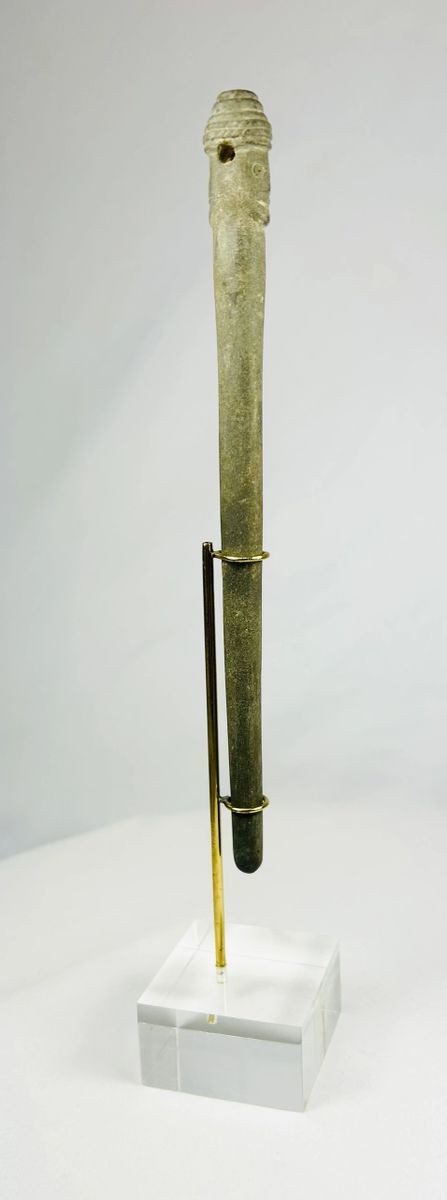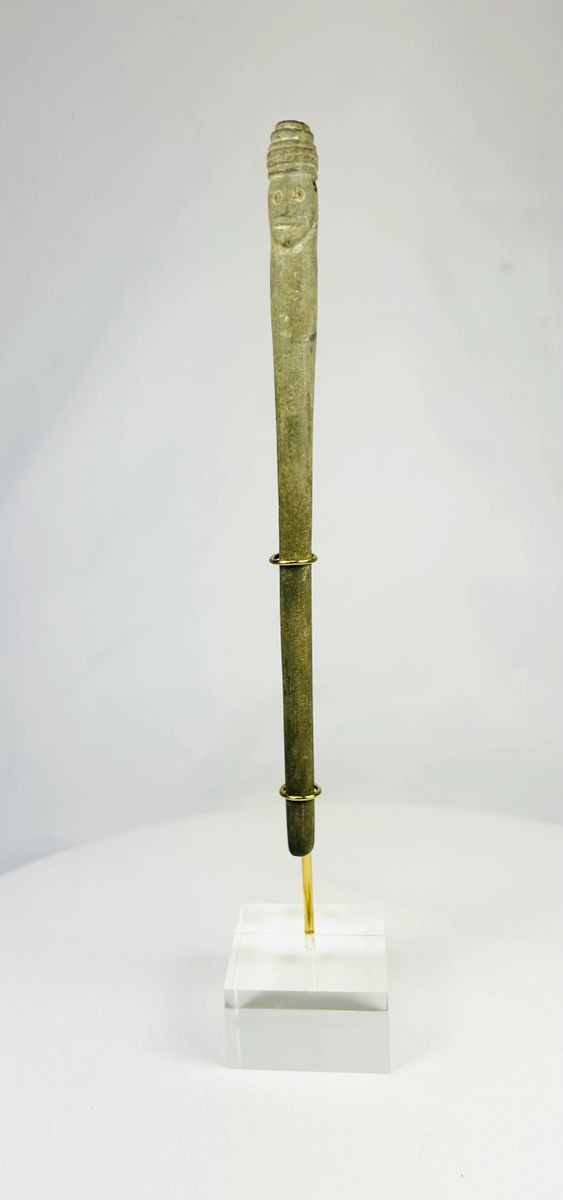Ancient Bactrian Wet Stone | Human Janus Head | Circa 2nd Millennium BC
Description
More
Less
Historical Context & Origin
Region: Central Asia, Bactrian-Margiana Cultural Complex
Material: Greenish-grey stone, likely chlorite or steatite
Period: 2nd Millennium BCE
Description
This remarkable artifact is a dual-faced (Janus-style) Bactrian wet stone, combining both functional and symbolic purposes. Used historically to sharpen tools such as knives, axes, and cutting implements, it also embodies ceremonial and ritualistic significance. The carved dual faces suggest symbolic associations with duality, balance, or ancestral representation, reflecting the cultural and spiritual traditions of the Bactrian people.
Features
- Dual-faced design with intricately carved symmetrical features
- Decorative ridges and fine detailing demonstrating advanced craftsmanship
- Substantial form, measuring approximately 10 inches in length
- Crafted from chlorite or steatite, materials prized for their durability and workability
Cultural Significance
While whetstones were utilitarian tools in antiquity, this example stands apart due to its elaborate dual-faced design. Such imagery may have represented gods, ancestors, or cosmological duality—concepts central to ancient iconography. Beyond its practical use, this stone likely served ceremonial or protective functions, emphasizing the interplay between daily life and spirituality in Bactrian society.
Condition
The wet stone survives in excellent condition with only minimal wear consistent with its age. Its smooth surface has developed a natural patina, testifying to centuries of burial and enhancing its authenticity and visual appeal.
Dimensions (approximate)
Length: 10 in
Age
Circa 2nd Millennium BCE
Learn More
Watch a Video on The Ancient Cities of Greek Bactria
Read More About The Meaning and History of Janus Heads
Check Out Our Curated Collection of Greek Artifacts
Description
Historical Context & Origin
Region: Central Asia, Bactrian-Margiana Cultural Complex
Material: Greenish-grey stone, likely chlorite or steatite
Period: 2nd Millennium BCE
Description
This remarkable artifact is a dual-faced (Janus-style) Bactrian wet stone, combining both functional and symbolic purposes. Used historically to sharpen tools such as knives, axes, and cutting implements, it also embodies ceremonial and ritualistic significance. The carved dual faces suggest symbolic associations with duality, balance, or ancestral representation, reflecting the cultural and spiritual traditions of the Bactrian people.
Features
- Dual-faced design with intricately carved symmetrical features
- Decorative ridges and fine detailing demonstrating advanced craftsmanship
- Substantial form, measuring approximately 10 inches in length
- Crafted from chlorite or steatite, materials prized for their durability and workability
Cultural Significance
While whetstones were utilitarian tools in antiquity, this example stands apart due to its elaborate dual-faced design. Such imagery may have represented gods, ancestors, or cosmological duality—concepts central to ancient iconography. Beyond its practical use, this stone likely served ceremonial or protective functions, emphasizing the interplay between daily life and spirituality in Bactrian society.
Condition
The wet stone survives in excellent condition with only minimal wear consistent with its age. Its smooth surface has developed a natural patina, testifying to centuries of burial and enhancing its authenticity and visual appeal.
Dimensions (approximate)
Length: 10 in
Age
Circa 2nd Millennium BCE
Learn More
Watch a Video on The Ancient Cities of Greek Bactria
Read More About The Meaning and History of Janus Heads
Check Out Our Curated Collection of Greek Artifacts
You May Also Like


























